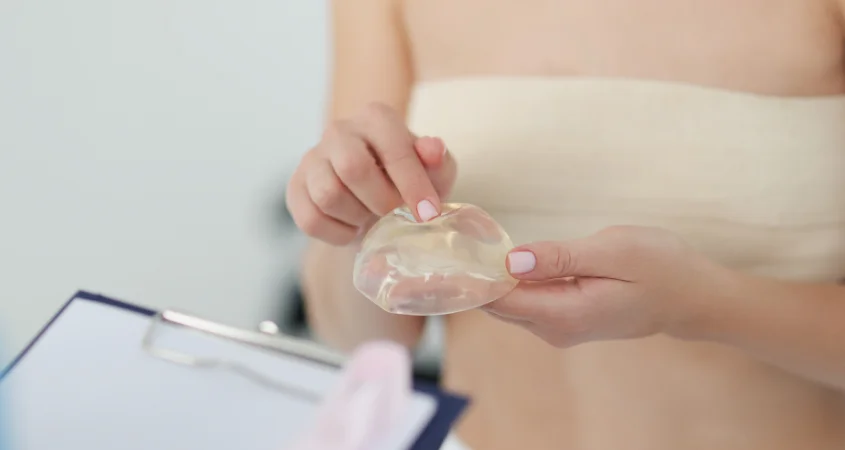Breast Lift vs. Augmentation: Understanding Your Options
By Partington Plastic Surgery on February 02, 2024 in Breast Augmentation

What is a Breast Lift?
Overview of Breast Lift Surgery
Mastopexy — sometimes called a breast lift, aims to raise and revitalize sagging breasts to create a tighter, younger-looking appearance. A surgical technique is used to treat drooping skin that can be brought on by aging naturally, pregnancy, breastfeeding, changes in body weight, and genetic susceptibility.
Improved symmetry can be achieved with a breast lift treatment that includes nipple-areola complex relocation, tightening of the surrounding tissues, and removal of excess skin. A variety of procedures are available to surgeons, including the anchor (inverted T) lift, lollipop (vertical), donut (periareolar), and crescent lifts.
The degree of sagging and each patient’s unique architecture is taken into consideration when choosing these treatments. For plastic surgeons to give their patients the finest results possible, proficiency in these techniques is essential.
The benefits of mastopexy, potential side effects, and the recovery period — which includes temporary bruising and swelling — should all be known to women considering the treatment. After a few weeks, though, most women usually get back to their regular routines.
Benefits of a Breast Lift
Breast lift or mastopexy, is an option to treat breast sagging caused by aging, pregnancy, breastfeeding, and major weight swings. Surgery can considerably improve a patient’s psychological well-being in addition to improving their cosmetic look by reshaping and elevating the breasts to create a more youthful contour.

A well-executed breast lift not only enhances garment comfort and fit, but it can also help regain equilibrium and lessen pain behind the breast crease. Furthermore, a lot of patients have reported that having surgery has enhanced their perception of their bodies and sense of value. This indicates that the procedure can have an equivalent positive impact on mental and physical wellness.
What is Breast Augmentation?
Overview of Breast Augmentation Surgery
A frequent cosmetic procedure, breast augmentation surgery seeks to improve the attractiveness, reconstruct breasts following mastectomy, and repair defects acquired later in life or those present from birth. To increase breast size, correct asymmetry, and create the desired form, this therapy involves placing implants, which might be silicone gel, beneath the breast tissue or chest muscles.
The surgeon cuts in a discrete spot to lessen the presence of scars after giving the patient anesthesia. In the armpit, periareolar (around the nipple), transaxillary (under the breast), and inframammary fold (under the breast) are common places to make incisions. Anatomical considerations including implant type, intended enlargement, patient anatomy, and surgeon choice all play a role in where the incision is made.
Advancements in surgical methods and implant technology have improved outcomes significantly, reducing issues and raising patient satisfaction. To minimize hazards and attain optimal results, meticulous preoperative preparation and thoughtful patient selection are essential.

This necessitates a thorough understanding of anatomical variations, patient preferences, and any elements that would render the surgery inappropriate. Therefore, in order to maintain the highest standard of care in breast augmentation surgeries, it is essential to give medical professionals and cosmetic surgeons continual education and training.
Benefits of Breast Augmentation
Breast augmentation is a significant reconstructive option for post-mastectomies patients since it helps regain their feeling of self and physical equilibrium. Additionally, there are now far fewer problems as a result of advancements in surgery and implant materials, which enhance therapy efficacy and safety.
In addition to its well-known aesthetic benefits, breast augmentation has additional health benefits. Its assistance with reconstructive surgery — specifically for individuals who underwent a mastectomy due to breast cancer — is one of the primary medicinal benefits. This procedure makes it easier to restore the natural shape of the breast, which improves the patient’s perception of their body and emotional health.
Furthermore, breast augmentation can correct acquired or congenital breast irregularities, giving the breasts a more balanced appearance and a more usual form. This treatment can improve the function of the muscles and surrounding tissues in the chest as well as alleviate physical discomfort.

Breast augmentation may be advantageous for people who have visible asymmetry in order to attain a more balanced breast size. This can assist in resolving issues related to poor posture or back pain brought on by an uneven weight distribution.
Comparing Breast Lift and Augmentation
Key Differences Between Procedures
Breast lifts and augmentation are two different aesthetic procedures related to the breast. Repositioning and contouring sagging breasts is the main objective of a breast lift, leading to an appearance that is more young and uplifted.
This operation includes skin removal and firming of the surrounding tissue to support the newly created breast. By comparison, breast augmentation attempts to increase the size and volume of the breasts with the use of implants or fat transfer.
Breast augmentation is typically the preferred option for patients who require greater breast volume and projection; however, breast lifts may be the greatest choice for individuals who are worried about sagging or unequal breasts.
All cosmetic objectives can be achieved by doing both procedures at the same time, even if they have different objectives and treat separate aspects of the anatomy and form of the breasts. Patients must be informed of these variances so that they can make decisions that align with their intended goals and anatomical concerns.
Natural Look
Confident Beauty
24 Hour Rapid Recovery, Muscle Sparing.

Factors to Consider When Choosing Between a Lift and Augmentation
When choosing the right surgical strategy for a certain patient, it is crucial to consider a number of important factors for the best possible results. For those with noticeable breast ptosis, a breast lift is typically recommended as a way to elevate and reconstruct the breast tissue without appreciably altering its size.
Speaking about breast lift vs augmentation, breast augmentation is usually recommended for those who want to enlarge their breasts and improve their overall fullness. This procedure occasionally makes use of fat grafting methods or implants.
In-depth preoperative discussions about breast lift vs breast augmentation are required to ensure that surgical plans complement the goals of the patient. Aesthetic objectives and patient expectations are also very important.

Among the health factors that affect the decision-making of choosing breast lift and breast augmentation are past medical histories, smoking habits, and possible surgical risks. The surgeon’s knowledge and suggestions, derived from a thorough assessment, are crucial for customizing the intervention to the patient’s unique needs. Examination of breast lift vs breast augmentation variables guarantees that the selected surgery will successfully meet the patient’s cosmetic and therapeutic needs.
Cost Considerations
A comprehensive understanding of the breast lift with augmentation cost involved is essential for patients to make proper planning since many patients find that the price of breast surgery is a significant consideration. The average price range for a mastectomy (breast lift) is $4,000–8,000.
Variables like the surgeon’s reputation, the procedure’s intricacy, and the patient’s location affect the cost. But, breast augmentation, sometimes referred to as augmentation mammoplasty, typically costs between $5,000 and $10,000. Implants incur additional costs, which vary based on the type and brand and can cost anywhere from $1,000 to $2,500 each.
Making an Informed Decision
During the collaborative process, doctors give detailed information about the diagnosis, therapies that are available, possible risks and advantages, and alternative techniques. Through interactive information sharing, patients can take an active role in their treatment, ensuring that medical procedures are tailored to their individual lifestyles, interests, and points of view.
For healthcare workers, creating an atmosphere that supports open communication and collaborative decision-making is crucial. In addition to increasing patient trust and treatment compliance, it supports patient autonomy and informed consent.
Ultimately, making educated decisions is essential to patient-centered care because it guarantees that decisions about each patient’s specific requirements and circumstances are taken into account.
Summary: Realistic Outcomes and Recovery Times
Candidates for plastic surgery must be fully aware of the practical outcomes and recovery times linked to breast lift and augmentation when assessing surgical options for breast enhancement. The primary goal of breast lift procedures is to tighten the surrounding tissue and remove extra skin from the breasts, raising and straightening them to give the illusion of younger breasts.
The majority of patients return to their regular activities after 24-48 hours of surgery with 24-hour Recovery Breast Augmentation. Postoperative recovery frequently involves minor discomfort and inflammation. Conversely, breast augmentation focuses on augmenting breast volume and size through the insertion of implants, which makes a major difference in the breasts’ look.
Return to Overview